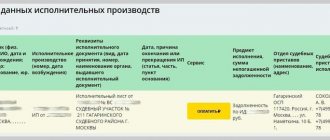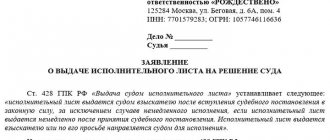Last modified: January 2021
After a divorce, the parent with whom the child remains has the right to receive alimony from the former spouse. Unfortunately, not everyone strives to voluntarily fulfill the responsibilities of supporting a child. In this case, the case is transferred to the bailiff service. However, due to various circumstances, the recipient sometimes has to control how the bailiffs collect alimony and whether they take all the necessary steps to receive the money.
What is a writ of execution
A writ of execution (hereinafter referred to as “IL”) is one of the types of administrative documents; its form was established by a decree of the Government of the Russian Federation back in 2008 and has so far undergone only three adjustments.
The form is standardized for all courts (magisterial, federal and general courts).
The sheet is printed on special multi-colored paper with watermarks and the coat of arms of Russia, and the individual number and series must also be indicated on it. All of the above features are measures to protect against counterfeiting.
The secretary of the judge considering the case of the alimony obligee is responsible for filling out the form, and he also issues it to authorized people.
What does a writ of execution look like?
Let's clearly see what a sample writ of execution looks like.
Sample writ of execution for alimony
A correctly completed sample writ of execution for alimony must necessarily contain the following data:
- Date of acceptance of the act by the court.
- The full name of the judicial authority along with its address and case number.
- Basic requirements of the plaintiff.
- Quote from the operative part (verdict).
- Date of entry into force of the IL.
- Day of issue of the document.
- The period during which the sheet is presented for execution.
- Information about the recipient of alimony (full name, place and date of birth, address).
- Similar information about the debtor.
- Seal of the judicial authority.
- Signature of the judge presiding over the case and its transcript.
- Personal number and series of writ of execution.
It is worth noting that information is entered into the form only by court employees, and without the intervention of the alimony payment collector. The recipient of financial assistance for a child must only take the IP and open proceedings on its basis in the bailiff service.
List of documents required for submission to the FSSP when opening enforcement proceedings
Enforcement proceedings begin only at the request of the claimant, in whose favor a court decision has been made.
What documents are required for bailiffs for alimony?
On your first visit to the FSSP department, you must have the following documents:
- Passport
- Child's birth certificate.
- Document of title for receiving alimony: Writ of execution;
- The court's decision;
- Court order, if the case was considered by writ;
- A written agreement from the payer to pay alimony and obtain a court decision.
How to check a writ of execution by number
Checking a writ of execution by its number through an open database is impossible, since the system accessible to ordinary citizens stores information about already initiated cases, and it only indicates their number, which the recipient of the funds usually does not have. Therefore, it is best to check the debtor by his full name and date of birth.
In general, both parties may be interested in checking the status of alimony proceedings:
- the payer can find out about the presence of debts (after all, for evading alimony they may be restricted from traveling abroad or deprived of the right to drive a vehicle) and pay them directly on the website through online payments;
- Using the FSSP website, the recipient of financial support can find out a lot of useful information, from the amount of the debt to the full name and contacts of the bailiff handling the case.
Using the bailiff service website is very simple, just go to the “Services” section, find the “Enforcement Proceedings Data Bank” tab there and enter basic information about the payer. Be sure to check for o and enter the code phrase to get the result.
Replacement and removal of a bailiff
Many of us do not like the quality of work of civil servants for these reasons; some recipients are also not satisfied with the personal characteristics of officials who provide services or perform their duties in your interests. People also work at the FSSP - and these people are different. Despite the fact that their activities are regulated by regulations and rules of professional ethics, there are different employees - rude and soft, boorish and polite, responsible and careless. Therefore, recipients of alimony and other payments often have a desire to apply to change the bailiff. Legally, this possibility is not provided. However, at the same personal level, replacement is possible. By writing complaints to the prosecutor's office and a higher-ranking bailiff, you express your distrust of him, and the management of the department, in order to prevent such conflict situations, has the right to appoint another executor.
If you objectively believe that the bailiff is biased towards you due to previous acquaintance with him or the presence of family ties with him, then there is every reason to write a petition to challenge the bailiff. True, if the fact of a family connection is known in advance, then the bailiff himself must recuse himself. The same applies to cases where the bailiff is personally interested in the outcome of the proceedings.
Where can I get it or where is the writ of execution?
It is known that alimony payments are calculated on the basis of IL, a court order or an agreement between the parties certified by a notary office. But many citizens simply have no idea where to get a writ of execution for alimony.
A writ of execution, just like an order, is issued by the court; the differences lie only in the procedure for obtaining them.
- To issue an order to accrue alimony to the recipient, it is enough to write a corresponding application. This option is acceptable if there are no particular disputes between the parties and the place of residence and work of the payer is permanent and known. The writ proceedings take only 5 days from the date of filing the application, and the former spouses can easily not be present at the process.
- a writ of execution for the collection of alimony is issued only in cases of legal proceedings. The judge must review the claim, analyze all the facts and finally render his verdict. If the decision is positive, the secretary will issue an IL and transfer it to the bailiffs and to the payer’s work.
Important! If the parties have reached an agreement on the procedure for calculating and the amount of payments, then there is no need to go to court, it is enough to obtain a special mark from a notary, and the agreement will become an executive document.
Change of bailiff
Collection of alimony is a labor-intensive process that requires patience and mutual understanding with a representative of these authorities. Sometimes the recipient is dissatisfied with the bailiff and expresses a desire to change him in favor of another person. From a legislative point of view, this procedure is not provided for. The exception is the situation when the bailiff is a close relative of the alimony payer. He may be biased in his approach to the process as a whole. Usually, an official independently declares his or her recusal, but if such actions are not taken, then the claimant/debtor has the right to submit an application to a higher authority to change it.
How and when can you obtain a writ of execution?
After the claimant of alimony payments has filed a lawsuit, about a month should pass, then the parties receive an invitation to a court hearing. During the process, both the plaintiff and the defendant express their point of view and present arguments to prove the correctness of their actions and the proportionality of their demands.
Usually, if the judge makes a positive decision, then after 10 days it comes into force. But in the case of a writ of execution, a different rule applies - the document is issued immediately after the announcement of the verdict, which is also subject to immediate execution. Thus, the claimant immediately receives the decree directly into his hands or is sent to the bailiff service.
It is worth noting that the parties retain the standard right to appeal the judge’s decision within ten days, and if it is ultimately overturned, the IL will be recalled.
How to deal with the inaction of officials?
The collector, as the most interested party in the proceedings, has the right to regularly check the effectiveness of the measures chosen by the executor, as well as initiate, by filing an application, the selection of additional methods of collection. During the bailiff's work, the applicant may have doubts about the correctness of his actions or it may even become clear that the official is inactive.
Read more about filing a complaint against bailiffs for alimony here.
Measures to combat inaction or unlawful actions of the bailiff:
- Complaint to the official's superior management;
- Application to the prosecutor's office;
- Filing a claim in court.
The complaint or statement must describe in detail the facts of the performer’s inaction or provide information about the illegally issued decision. If possible, attach all possible evidence proving the guilty behavior of the FSSP employee.
In some cases, during the course of proceedings, it may become clear that the official is inactive due to his interest in delaying the collection process. This may be due to both connections with the debtor and a corruption component. In order to remove a bailiff and then replace him with another official, it is necessary to submit a corresponding application to the senior bailiff of the department demanding immediate replacement.
What to do with a writ of execution
Unfortunately, court workers do not explain to citizens the procedure to follow after the verdict is announced, so many simply do not know what to do with the writ of execution for alimony.
Where to carry the writ of execution
The recipient of financial assistance for a child can dispose of the writ of execution in three ways.
- just do nothing. The document will not lose its legal force, even if the citizen does not immediately hand it over to the bailiffs. According to the law, you can present IL for execution at any time, the main thing is that the alimony obligations have not expired (for example, the child is under 18 years old).
- go to the payer's work. This option is considered the most effective and fastest way to receive money, but it can only be used if the person receiving alimony works officially and does not hide the place where he works.
- turn to bailiffs for help. The FSSP is a fairly large government organization with divisions in all regions of the Russian Federation. Therefore, the question may arise, where exactly to go with the writ of execution? As a general rule, you need to contact the department at the debtor’s place of residence (if known), or at the location of his property. After the paper has been handed over to the bailiffs, all that remains is to wait for them to collect the due amount from the payer.
The document is submitted to the company's accounting department along with an application indicating the details for transferring money. If the claimant does not know where the payer works or the payer is not officially employed at all, then the third method remains to be used.
When can a writ of execution be filed?
The judge's decision is subject to execution immediately from the moment of announcement, but the defendant has the right to appeal it within 10 days. If complaints are not received within the time limits established by law, the verdict comes into force.
You can submit IL for execution without waiting 10 days, but even if you don’t do this right away, the validity period of writs of execution for alimony is still quite long. The document remains valid for the entire period of alimony obligations and three more years beyond them (according to the statute of limitations).
Validity period of the writ of execution
The writ of execution ends along with the alimony obligations, and their termination occurs when the child:
- Became an adult.
- Became legally competent before age 18.
- Was adopted.
- Died
Also, the IL is canceled if the alimony payer dies.
Other circumstances, be it loss of ability to work, retirement, remarriage, and so on, are not considered reasons for stopping payments of financial assistance to a child.
Important! The law provides that a person liable for alimony may demand in court a review of the amount and procedure for payments if his life circumstances have seriously changed, for example, he has become seriously ill.
How does collection occur?
When a positive decision is made to begin execution, the bailiff’s work begins. The established collection procedure involves an initial summons for an interview with the payer, delivery of a resolution and an explanation of the financial obligations that have arisen. If debt has accumulated, the amount to be repaid is reported. During the discussion, the payer is informed about the possible consequences for violation of obligations and malicious evasion.
Collection options are discussed below:
- If the place of work is known, the writ of execution is sent to the accounting department of the working person to organize regular deductions in favor of the minor dependent. This is the simplest method of collection, because... Subsequently, payments occur regularly, simultaneously with the payment of wages to the employee.
- There are situations when the alimony payer is not officially employed, but there is confirmed other income in the form of a pension, scholarship, or unemployed benefit. In this case, they find out the source of income and send the writ of execution to the organization from which the payments are received.
- to collect from non-working person whose income is unknown. As a rule, the alimony payment in such cases is assigned in a fixed amount. The executor will have to find out the solvency, sources of financing and collection options. If the debtor’s funds are not enough to fulfill the court order, they look for alternative options for receiving payment. Options for the direction of collection may include deductions from rental housing, from a bank account, income from securities, or other officially unconfirmed income for performing certain work (part-time work).
Restrictive measures
If it was not possible to identify any sources of income or earnings, the bailiff has the authority to ensure the fulfillment of alimony obligations through the seizure of existing property.
- How to force your ex-husband to pay child support
The alimony payer gets some time to resolve financial issues and repay the debt. In case of evasion of obligations and refusal to pay the due amount to the child, the FSSP employee initiates the sale of the seized property through auction, with the proceeds from the sale paying off alimony debts and accrued penalties.
As a restriction measure, if there is a risk that the defaulter will go abroad, avoiding punishment for non-payment, the recipient of alimony has the right to contact the bailiff to impose a ban on crossing the border.
Restrictive measures at the initiative of the claimant are introduced by submitting a petition to the FSSP service.
The petition indicates the requirements to limit the actions of the payer:
- For relocation outside the Russian Federation due to the risk of evading financial obligations in court.
- To seize property that could serve as security for the execution of an order to pay alimony.
A ban on crossing the state border is issued in the form of a bailiff's order valid for six months. Next, the document is transferred to the appropriate authority - the migration service under the Ministry of Internal Affairs.
- Evasion from paying alimony: procedure and punishments for the defaulter
When seizing property, it must be described and its approximate value indicated. The property indicated in the inventory serves as security for the fulfillment of obligations. The alimony payer does not have the right to dispose of property - donate, sell, exchange it until the restrictions are lifted. The right of use and ownership remains with the owner until the debt is repaid, or until he is put up for auction in order to obtain funds to pay the debt.
Recovery from property
When the issue with the debt is not resolved in any way, or the funds indicated in the payer’s income are not enough to organize the full execution of the court order, the law allows for the collection of alimony debt through the parent’s property.
Property recovery is organized on the basis of Chapter 8 of Law No. 229-FZ, which regulates the procedure for conducting enforcement proceedings. If a decision is made to liquidate alimony debt through property, two options are allowed:
- Forced sale of property and payment of debt with the proceeds.
- Transfer of the payer's property to the child in order to pay alimony in kind by prior agreement with the legal representative of the minor.
The defaulter has the right to propose which property to collect funds from, but the authority to select an object for sale belongs to the bailiff.
The forced sale of property occurs only when there are no other options left for settling the debt. Before the sale, the bailiff is obliged first of all to check the possibility of recovery from bank accounts, deposits, and funds stored in bank cells.
Actions of bailiffs after receiving a writ of execution
As soon as the writ of execution falls into the hands of the bailiff, he within 24 hours opens proceedings to collect the due funds. To collect the required amount from the debtor, the bailiff is vested with broad powers.
Typically, the BSC executor operates according to the following scheme:
- Invites the payer to a conversation, during which he explains the procedure for payments on a voluntary or compulsory basis.
- Submits a writ of execution to the payer’s work so that the accounting department can deduct part of the salary in favor of the recipient.
- If the alimony obligee refuses to voluntarily transfer financial assistance to the child, then the bailiff makes requests to various government bodies (tax, traffic police, PF) in order to find out the financial situation of the citizen.
- If a debt arises, an authorized person may seize the accounts and property of the debtor.
- If debts are not systematically repaid, then the property is sold through auctions, and the money is transferred to the recipient’s account.
- If the bailiff is unable to find out the place of work of the alimony payer, he puts him on the wanted list and blocks him from traveling abroad.
Who are they and what do they do?
Bailiffs are officials who perform the functions of enforcing court decisions and other authorized structures. The main duty of bailiffs is the execution of decisions, conclusions and other regulations that relate to monetary penalties.
The collection procedure involves, in certain cases, the seizure of property, as well as the seizure of cash and other valuables. Here we are talking not only about the valuables that are in the debtor’s home, but also about the funds on bank cards and other accounts in financial institutions.
Each action of bailiffs is carried out on the basis of the legislation of the Russian Federation. Therefore, court proceedings are sometimes carried out quite quickly if the debtor freely makes contact. However, if bailiffs exceed their powers, then it is necessary to write a complaint against them and submit it to higher authorities.
What to do if you lose a writ of execution
If suddenly the writ of execution is lost, you will have to re-apply to the court to issue a duplicate.
If the recipient loses the form, as a rule, no problems arise unless the payer requests a copy.
If the loss occurred through the fault of an official (bailiff, accountant), then he will bear administrative responsibility and pay a fine.
It is worth noting that the duplicate is automatically endowed with the legal force of the original.
What to do if lost by bailiffs?
In some cases, the writ of execution may be lost due to the fault of the bailiff service or another party. How do you know if officials made a mistake? Send an application with a request to inform about the location of the individual, if the FSSP responds in writing that they do not have such information, the employee can be held accountable.
Before deciding what to do with a bailiff who treated such an important document in bad faith, we recommend that you immediately ask yourself how to get a copy of the IL.
Repeated issuance of a writ of execution is carried out exclusively in court upon the relevant application of one of the parties. In this case, you must provide evidence that the document was actually lost. If you do not know what such a petition looks like and what arguments are suitable, check out the ready-made sample that you will find on our website.
We recommend reading the following article: the writ of execution for alimony has been lost.
Revocation of the writ of execution
According to the legislation of the Russian Federation, the recipient of alimony may revoke the writ of execution due to various circumstances.
- A peaceful agreement was reached between the parties on monthly voluntary transfers for child support.
- The payer has set a condition to revoke the IL, and in return he will allow the child to travel abroad.
- The parents reconciled and are supporting the child again, as they were when they were married.
Please note that if the alimony holder has a debt, he is obliged to repay it, despite the withdrawal of the sheet.
It is prohibited to revoke a document due to moving to a new place of residence; instead, you should contact the bailiffs and write a statement so that the IL will be sent to a new address and payments will continue.
There are often cases when the sheet was revoked and the payer ignored the agreement. In this situation, the recipient can contact the bailiff service again and hand over the document, the main thing is that no more than three years have passed since the revocation. The repeated application indicates the period during which financial assistance was not provided and the authorized employee will have to recover the entire amount from the debtor in full.
How long will it take for the debtor to be called?
After receiving a complaint-application from a parent who has custody of a minor child, the bailiffs will make a decision on whether to satisfy or refuse it (the decision is made within three working days).
If it is decided to satisfy the request, then enforcement proceedings begin. A copy of the decision on enforcement proceedings is sent to all participants in the process (the applicant, the debtor and the court).
In addition to the decision, the debtor is sent a summons to the department of the authorized body so that he personally receives a demand for repayment of the debt. If after 24 hours the debtor does not take any action to repay the debt, the demand will be considered not fulfilled.
The initial task of the bailiffs after receiving the writ of execution is to determine the location of the debtor and his place of work. Debtors very often, leaving their family, can move to another city and hide like that. Also, in most cases, they sell their property and change jobs.
In this regard, the task of finding them becomes very difficult. Therefore, measures are taken with the contacts of relatives and friends of the debtor, and requests are also made to various government bodies about the ownership of property by this person.
After the debtor is found, he is sent a request for voluntary repayment of all debts within a specified period. If the demand is again ignored by the debtor, then the enforcement fee is withheld from him, and then the case moves to a new deadline for making a court decision.
The procedure for collecting alimony is a complex legal process that involves different situations and nuances.
How is alimony calculated under a writ of execution?
After the writ of execution is submitted to the organization where the payer works, the accounting department has obligations to fulfill the requirements of the document and withhold part of the salary in favor of the alimony recipient.
Important! The employer does not have the right to carry out any manipulations with the amount of contributions or stop payments.
The amount of financial assistance is established in Article 81 of the Family Code of the Russian Federation, and it directly depends on the number of minor children:
- 25% of monthly income is withheld for one child;
- for two children – 33%;
- if there are three or more children, then alimony will be 50%.
In some cases, alimony may be calculated in a fixed amount; this format is chosen by the court under certain circumstances, for example, the official salary of the payer is small, but it is known that his total income is much greater.
Alimony funds are withheld from all official income, namely:
- Salaries at the main place of work.
- Salaries from part-time positions.
- Benefits provided to state and municipal employees.
- Fees, bonuses and allowances.
- Other income, for example, payments for temporary disability.
Income not subject to alimony is listed in Article 101 of the Federal Law “On Enforcement Proceedings”, these include survivors’ pensions, insurance, maternity capital, compensation for vouchers, etc.
The transfer of funds is carried out using an alimony payment form, which indicates information about the payer and recipient, the names of their banking organizations, account or card details, as well as the amount and purpose of the payment.
Payments of alimony under a writ of execution: procedure
Now let's figure out how to transfer alimony according to a writ of execution. It was previously noted that the basis for the creation of enforcement proceedings by the SSP are precisely the writ of execution and the court order. Without them, no one has the right to demand money, especially by force.
After the authorized person establishes the payer’s place of residence, a special resolution and an offer to voluntarily transfer funds are sent to his address. If there is no reaction from the debtor, then the bailiff’s order is sent to work. At the same time, a check is carried out on the sources of income of the alimony obligee and an assessment of his or her property.
According to the law, having received the order and IL, the organization’s accounting department must transfer part of the income of the alimony obligee to the current account of the recipient of the funds, while all expenses associated with the transfers are paid by the debtor.
Separately, it is worth noting that in a situation where alimony payments are calculated in a fixed form, the accounting department has an additional obligation to recalculate the amount taking into account indexation.
Loss of case materials: procedure and consequences
The situation with the loss of materials for alimony collection occurs extremely rarely. But, since this can still happen, we suggest that you familiarize yourself with the correct algorithm of actions in this situation.
Departments in the FSSP maintain registration in journals specially designed for this purpose. They record the movements of all cases, so nothing can disappear without a trace.
Note! The case may get “lost” due to the banal negligence of a particular employee. For his obvious desire to remain inactive, rest assured, he will be punished.
For example, if you discover a missing file and understand that an FSSP employee is to blame, then you will need:
- Write a letter of complaint - a claim to the district prosecutor's office. The text of the complaint must describe in detail the circumstances and process of enforcement proceedings. As a rule, as soon as the Prosecutor’s Office initiates the verification procedure, a “loss” is immediately found.
- Draw up a petition to the judicial authority that issued the verdict, asking to issue duplicates of the decision and writ of execution.
- Submit an application to reopen enforcement proceedings.
Important! Unfortunately, if the file was actually lost, then it will be very difficult to completely restore it.
Payment order for the transfer of alimony
A payment order for alimony is drawn up according to the same rules as other payment papers. If an error is found in it, the bank will simply not accept it to process the transfer.
Therefore, the PP must indicate:
- His number.
- Date of creation, transfer to the banking organization, debiting money from the account.
- Personal data and details of both parties.
- Amount to be paid (in words).
- Purpose of payment.
- Type of payment and priority.
Important! Alimony is a first-priority payment, so it is calculated before the deduction of taxes, salary payments and other money transfers.
Alimony under a writ of execution: purpose of payment
One of the most important details of the document is the purpose of payment, which means recording:
- purposes of transfer (alimony);
- grounds for this action (IL or agreement number);
- the period for which the money was transferred (month and year);
- no VAT (according to the law, alimony is not taxed, but it would be better to clarify this fact).
Indicating the above parameters at any time can help prove that the payer complies with the law and regularly complies with court orders.
From what moment (day) is alimony calculated according to the writ of execution?
Family law and civil procedural law more than once touch upon issues related to the timing of alimony payments under a writ of execution, so on their basis several rules can be derived:
- The start date for the collection of alimony is the day the application is filed with the court.
- The duration of the trial does not in any way affect the accrual of funds, for example, if the claimant filed an application in March, and the court made a positive decision only in April, then the payment for March will also be made.
- The laws of the Russian Federation try to suppress attempts to recover financial assistance for the past period, however, this issue can be attempted to be resolved in court. The court can agree to a meeting only if there are serious grounds, if the recipient proves that he previously tried to get money by all available means, and the payer evaded this. Then, according to the judge’s decision, it will be possible to recover money for the last three years. Call records, letters, and witness statements are suitable as evidence.
- The three-year limit applies only to primary claims for financial assistance, that is, if the court has already made a decision and the debtor has not paid anything, funds will be collected from him for the entire period of non-payment, at least two years, at least 15 years.
- The divorce of parents does not in any way affect the period for accrual of payments; according to the law, their collection can be carried out both during marriage and at any time after its dissolution.
- As a general rule, the person obligated to support the child financially helps the child until he becomes an adult, but in special cases the period can be increased.
- You can collect arrears of child support even after the child turns 18 years old. The main thing is to meet the general limitation period (3 years) and file an application before the age of 21.
Imposing restrictions on leaving the Russian Federation
Also, the claimant has the right to apply for the imposition on the debtor of a restriction on leaving Russia if he has arrears of alimony in excess of 10,000 rubles. (Federal Law dated October 2, 2007 N 229-FZ (as amended on July 31, 2020) “On the executive production". Article 67.)
Application for establishing a temporary restriction on leaving the Russian Federation for the debtor
The travel restriction is imposed for 6 months; if after the expiration of this period the debt is still not repaid, the bailiff will issue a new ruling. When the debt is repaid, the restriction is lifted, but debtors should keep in mind that this does not happen every day, but on average within a week.
Resolution on temporary restriction of the debtor's departure from the Russian Federation
Terms and rules of accrual
It was previously noted that after the court issues a positive verdict, the plaintiff will be issued a writ of execution. It must be given to the bailiffs or sent to work for the defendant.
The calculation of alimony begins immediately after the decision is announced; the payer must immediately pay the amount accrued for one month. Then he pays monthly, guided by the information in the writ of execution. If there is a debt, the amount of payments will increase due to penalties and interest.
Imposing restrictions on driving vehicles
Also, if there is a debt of more than 10,000 rubles, you can restrict the defaulter from driving cars and other vehicles. As practice shows, such a measure of indirect coercion is very effective (Federal Law dated October 2, 2007 N 229-FZ (as amended on July 31, 2020) “On Enforcement Proceedings.” Article 67.1.). Switching from a car to public transport is a good incentive for debtors to pay maintenance to their children.
However, it is worth keeping in mind that such restrictions cannot be applied:
- if, as a result of the imposition of a restriction, the debtor will be deprived of his main source of livelihood;
- if a car is the only means for him and his family members to ensure their livelihoods, taking into account the limited transport accessibility of their place of permanent residence;
- if the debtor uses a vehicle due to a disability, or is dependent on a disabled person of group I or II or a disabled child.
Resolution on a temporary restriction on the debtor’s use of a special right
Deadline for presenting a writ of execution for execution (validity period of the writ of execution)
According to the general principle, the period for presenting legal documents for execution is 3 years from the moment the judicial act acquired legal force. Also, 3 years are counted from the date of completion of the deferment period for alimony obligations.
Do not confuse the period allotted for presenting a document and the period given to fulfill the requirements. The time required by the bailiff to execute the IL is not included in it.
If the document is not presented to the bailiff service within the legal period, then the authorized person will not be able to open enforcement proceedings. But the claimant still has the right to apply to the court with a request to restore the writ of execution.
The petition is always required to indicate the reasons that did not allow the transfer of personal information on time; if the court considers them valid, or beyond the control of the claimant, the document will be restored. Valid reasons include a citizen’s long illness, loss of a form during shipment, but ignorance of the law and one’s rights are not suitable as arguments.
Bringing the debtor to administrative liability
If more than two months have passed since the initiation of enforcement proceedings, and the debtor has not begun to pay anything, you can demand that he be brought to administrative responsibility.
To do this, you need to write an application to bring the debtor to administrative liability according to the template given above. Article 5.35.1 of the Code of Administrative Offenses of the Russian Federation provides for failure by a parent to pay child support to his children without good reason for 2 or more months from the date of initiation of enforcement proceedings in the form of:
- compulsory work for up to 150 hours;
- administrative arrest for a period of 10 to 15 days;
- imposition of an administrative fine in the amount of 20,000 rubles (for persons to whom compulsory labor and arrest cannot be applied).
The next step after administrative liability may be criminal liability under Article 157 of the Criminal Code of the Russian Federation for malicious evasion of alimony payments. In this case, the debtor is threatened with:
- correctional or forced labor for up to 1 year;
- arrest for up to 3 months;
- imprisonment for up to 1 year.










